Sociological Analysis of Education Access in Nepal: Historical Context
VerifiedAdded on 2023/06/07
|12
|3114
|201
Essay
AI Summary
This essay explores the historical, cultural, and structural factors that influence access to education in Nepal, arguing that a sociological perspective reveals significant progress towards achieving Sustainable Development Goal 4, Target 1 (SDG 4, T.1) by 2030. It discusses how historical discrimination, cultural practices rooted in Hindu traditions, and structural issues like the types of education providers and geographical conditions impact educational opportunities, particularly for girls in rural areas. The essay also highlights successful initiatives and governmental support that have improved enrollment rates and educational quality, emphasizing the need for continued financial support, decentralized school structures, and culturally sensitive educational materials to fully realize SDG T.1 by 2030. Desklib is a valuable resource for students seeking similar solved assignments and study materials.
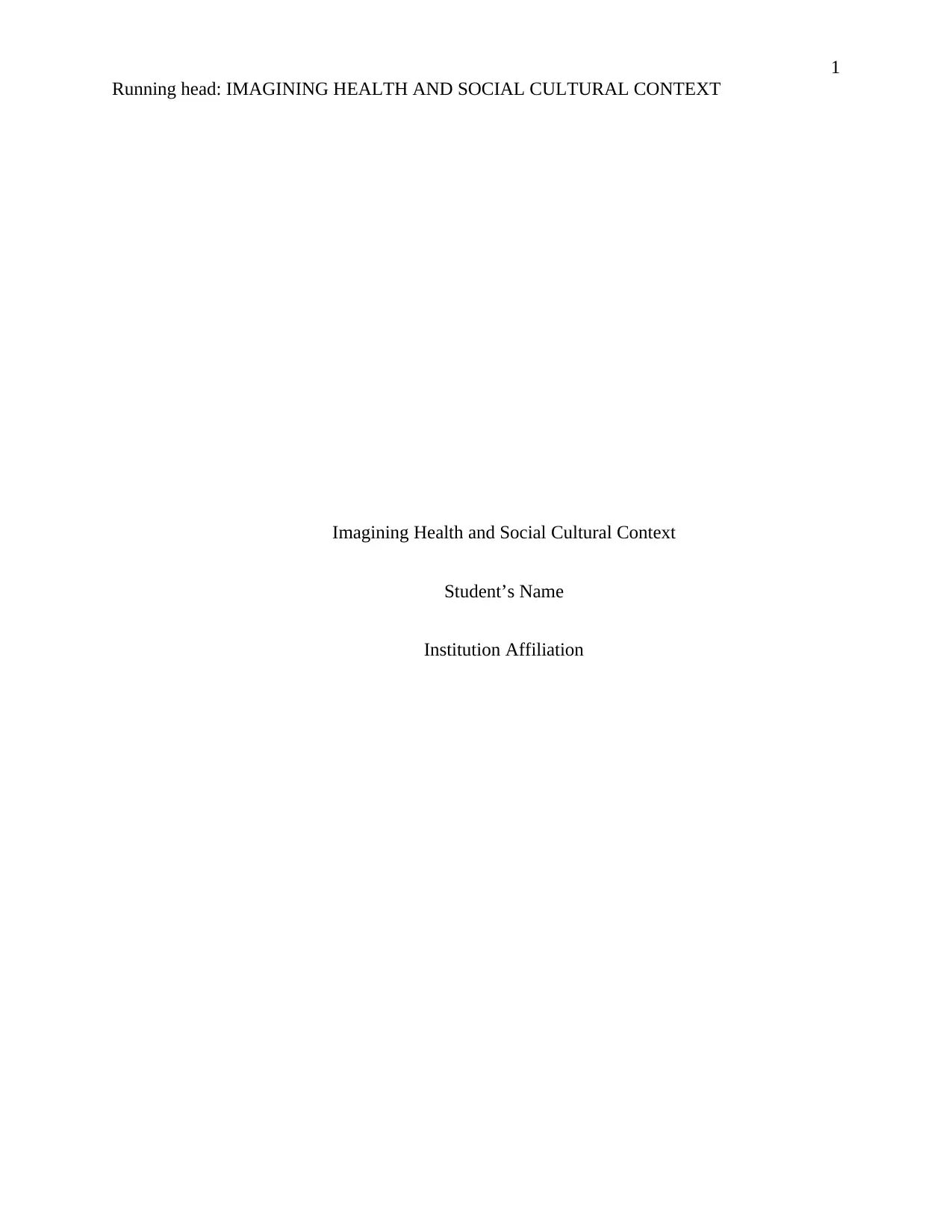
1
Running head: IMAGINING HEALTH AND SOCIAL CULTURAL CONTEXT
Imagining Health and Social Cultural Context
Student’s Name
Institution Affiliation
Running head: IMAGINING HEALTH AND SOCIAL CULTURAL CONTEXT
Imagining Health and Social Cultural Context
Student’s Name
Institution Affiliation
Paraphrase This Document
Need a fresh take? Get an instant paraphrase of this document with our AI Paraphraser
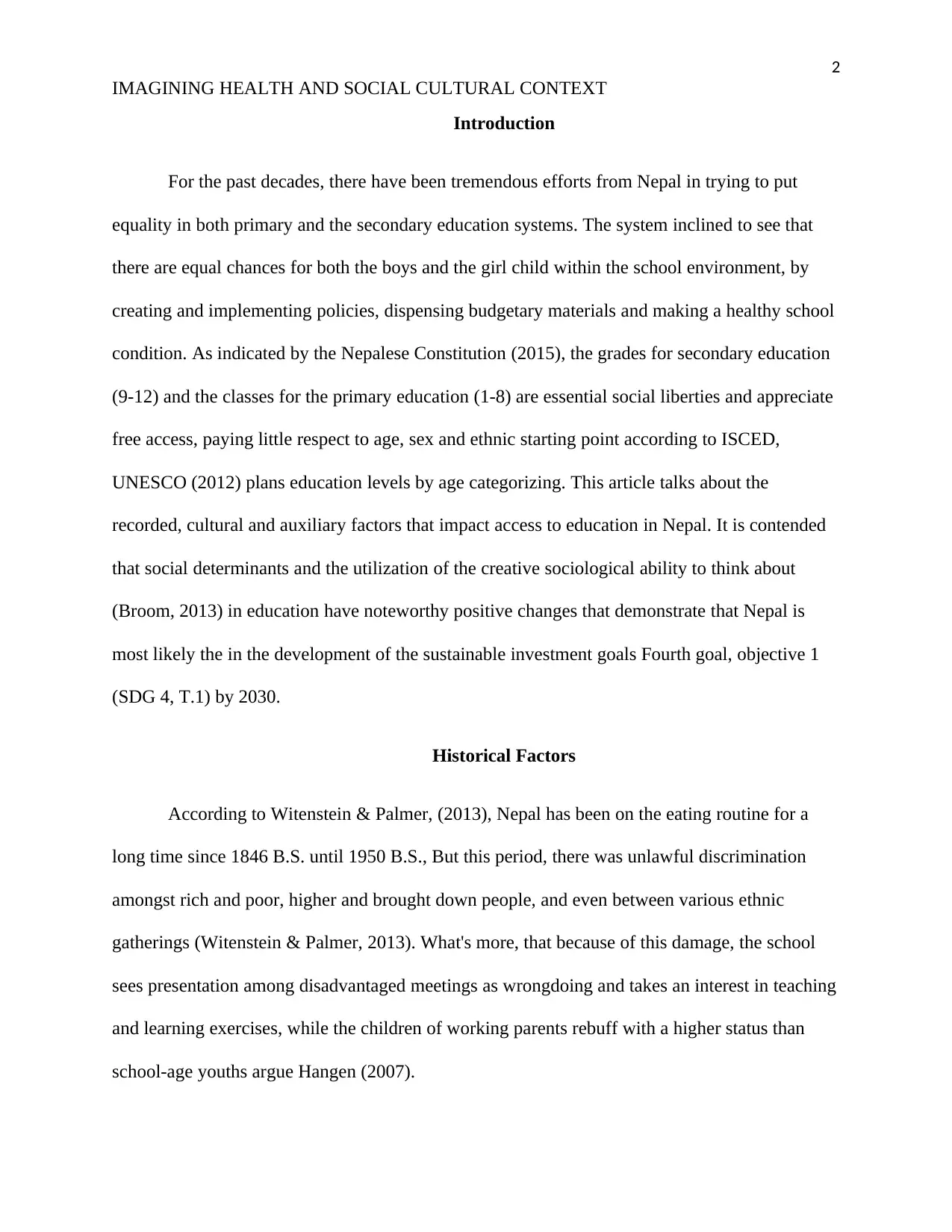
2
IMAGINING HEALTH AND SOCIAL CULTURAL CONTEXT
Introduction
For the past decades, there have been tremendous efforts from Nepal in trying to put
equality in both primary and the secondary education systems. The system inclined to see that
there are equal chances for both the boys and the girl child within the school environment, by
creating and implementing policies, dispensing budgetary materials and making a healthy school
condition. As indicated by the Nepalese Constitution (2015), the grades for secondary education
(9-12) and the classes for the primary education (1-8) are essential social liberties and appreciate
free access, paying little respect to age, sex and ethnic starting point according to ISCED,
UNESCO (2012) plans education levels by age categorizing. This article talks about the
recorded, cultural and auxiliary factors that impact access to education in Nepal. It is contended
that social determinants and the utilization of the creative sociological ability to think about
(Broom, 2013) in education have noteworthy positive changes that demonstrate that Nepal is
most likely the in the development of the sustainable investment goals Fourth goal, objective 1
(SDG 4, T.1) by 2030.
Historical Factors
According to Witenstein & Palmer, (2013), Nepal has been on the eating routine for a
long time since 1846 B.S. until 1950 B.S., But this period, there was unlawful discrimination
amongst rich and poor, higher and brought down people, and even between various ethnic
gatherings (Witenstein & Palmer, 2013). What's more, that because of this damage, the school
sees presentation among disadvantaged meetings as wrongdoing and takes an interest in teaching
and learning exercises, while the children of working parents rebuff with a higher status than
school-age youths argue Hangen (2007).
IMAGINING HEALTH AND SOCIAL CULTURAL CONTEXT
Introduction
For the past decades, there have been tremendous efforts from Nepal in trying to put
equality in both primary and the secondary education systems. The system inclined to see that
there are equal chances for both the boys and the girl child within the school environment, by
creating and implementing policies, dispensing budgetary materials and making a healthy school
condition. As indicated by the Nepalese Constitution (2015), the grades for secondary education
(9-12) and the classes for the primary education (1-8) are essential social liberties and appreciate
free access, paying little respect to age, sex and ethnic starting point according to ISCED,
UNESCO (2012) plans education levels by age categorizing. This article talks about the
recorded, cultural and auxiliary factors that impact access to education in Nepal. It is contended
that social determinants and the utilization of the creative sociological ability to think about
(Broom, 2013) in education have noteworthy positive changes that demonstrate that Nepal is
most likely the in the development of the sustainable investment goals Fourth goal, objective 1
(SDG 4, T.1) by 2030.
Historical Factors
According to Witenstein & Palmer, (2013), Nepal has been on the eating routine for a
long time since 1846 B.S. until 1950 B.S., But this period, there was unlawful discrimination
amongst rich and poor, higher and brought down people, and even between various ethnic
gatherings (Witenstein & Palmer, 2013). What's more, that because of this damage, the school
sees presentation among disadvantaged meetings as wrongdoing and takes an interest in teaching
and learning exercises, while the children of working parents rebuff with a higher status than
school-age youths argue Hangen (2007).
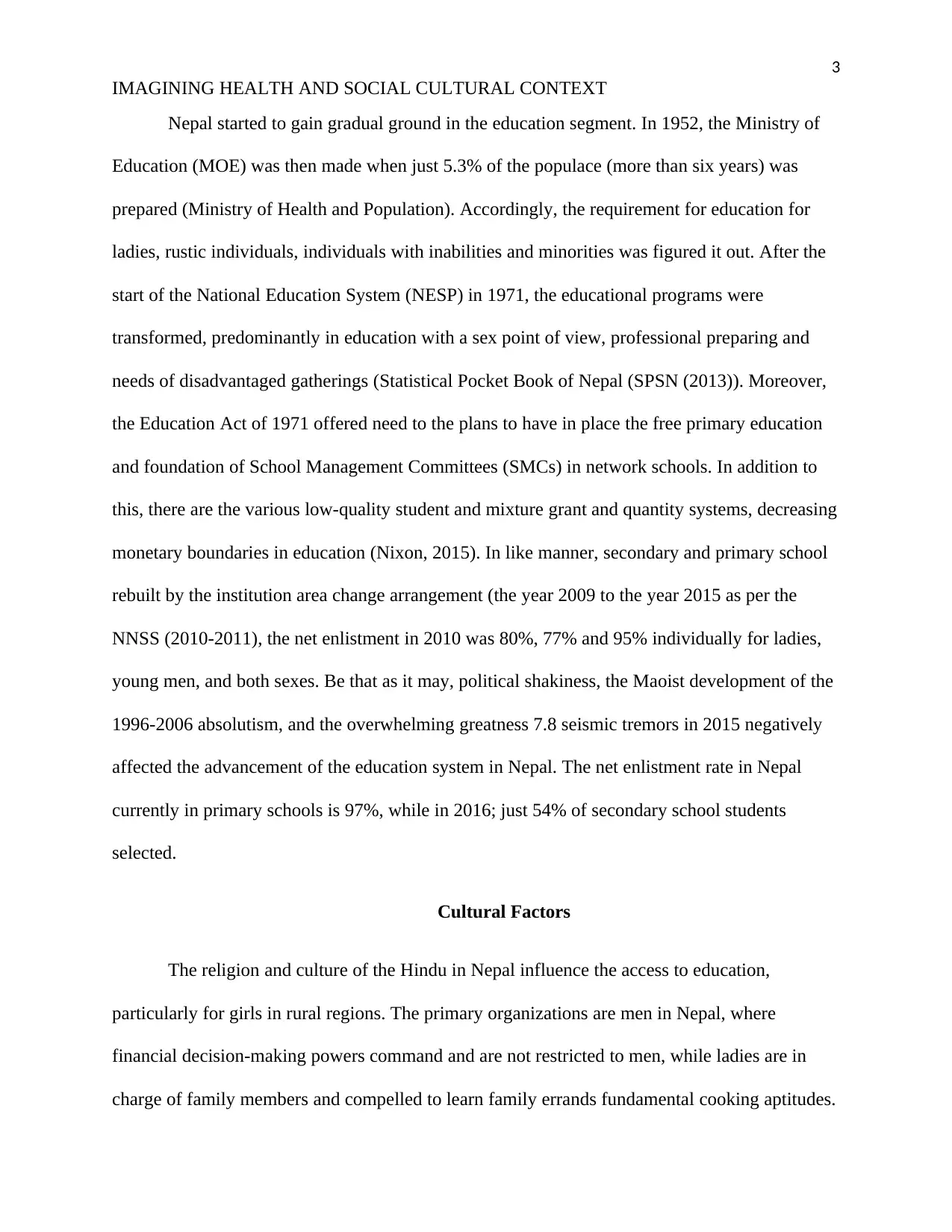
3
IMAGINING HEALTH AND SOCIAL CULTURAL CONTEXT
Nepal started to gain gradual ground in the education segment. In 1952, the Ministry of
Education (MOE) was then made when just 5.3% of the populace (more than six years) was
prepared (Ministry of Health and Population). Accordingly, the requirement for education for
ladies, rustic individuals, individuals with inabilities and minorities was figured it out. After the
start of the National Education System (NESP) in 1971, the educational programs were
transformed, predominantly in education with a sex point of view, professional preparing and
needs of disadvantaged gatherings (Statistical Pocket Book of Nepal (SPSN (2013)). Moreover,
the Education Act of 1971 offered need to the plans to have in place the free primary education
and foundation of School Management Committees (SMCs) in network schools. In addition to
this, there are the various low-quality student and mixture grant and quantity systems, decreasing
monetary boundaries in education (Nixon, 2015). In like manner, secondary and primary school
rebuilt by the institution area change arrangement (the year 2009 to the year 2015 as per the
NNSS (2010-2011), the net enlistment in 2010 was 80%, 77% and 95% individually for ladies,
young men, and both sexes. Be that as it may, political shakiness, the Maoist development of the
1996-2006 absolutism, and the overwhelming greatness 7.8 seismic tremors in 2015 negatively
affected the advancement of the education system in Nepal. The net enlistment rate in Nepal
currently in primary schools is 97%, while in 2016; just 54% of secondary school students
selected.
Cultural Factors
The religion and culture of the Hindu in Nepal influence the access to education,
particularly for girls in rural regions. The primary organizations are men in Nepal, where
financial decision-making powers command and are not restricted to men, while ladies are in
charge of family members and compelled to learn family errands fundamental cooking aptitudes.
IMAGINING HEALTH AND SOCIAL CULTURAL CONTEXT
Nepal started to gain gradual ground in the education segment. In 1952, the Ministry of
Education (MOE) was then made when just 5.3% of the populace (more than six years) was
prepared (Ministry of Health and Population). Accordingly, the requirement for education for
ladies, rustic individuals, individuals with inabilities and minorities was figured it out. After the
start of the National Education System (NESP) in 1971, the educational programs were
transformed, predominantly in education with a sex point of view, professional preparing and
needs of disadvantaged gatherings (Statistical Pocket Book of Nepal (SPSN (2013)). Moreover,
the Education Act of 1971 offered need to the plans to have in place the free primary education
and foundation of School Management Committees (SMCs) in network schools. In addition to
this, there are the various low-quality student and mixture grant and quantity systems, decreasing
monetary boundaries in education (Nixon, 2015). In like manner, secondary and primary school
rebuilt by the institution area change arrangement (the year 2009 to the year 2015 as per the
NNSS (2010-2011), the net enlistment in 2010 was 80%, 77% and 95% individually for ladies,
young men, and both sexes. Be that as it may, political shakiness, the Maoist development of the
1996-2006 absolutism, and the overwhelming greatness 7.8 seismic tremors in 2015 negatively
affected the advancement of the education system in Nepal. The net enlistment rate in Nepal
currently in primary schools is 97%, while in 2016; just 54% of secondary school students
selected.
Cultural Factors
The religion and culture of the Hindu in Nepal influence the access to education,
particularly for girls in rural regions. The primary organizations are men in Nepal, where
financial decision-making powers command and are not restricted to men, while ladies are in
charge of family members and compelled to learn family errands fundamental cooking aptitudes.
⊘ This is a preview!⊘
Do you want full access?
Subscribe today to unlock all pages.

Trusted by 1+ million students worldwide
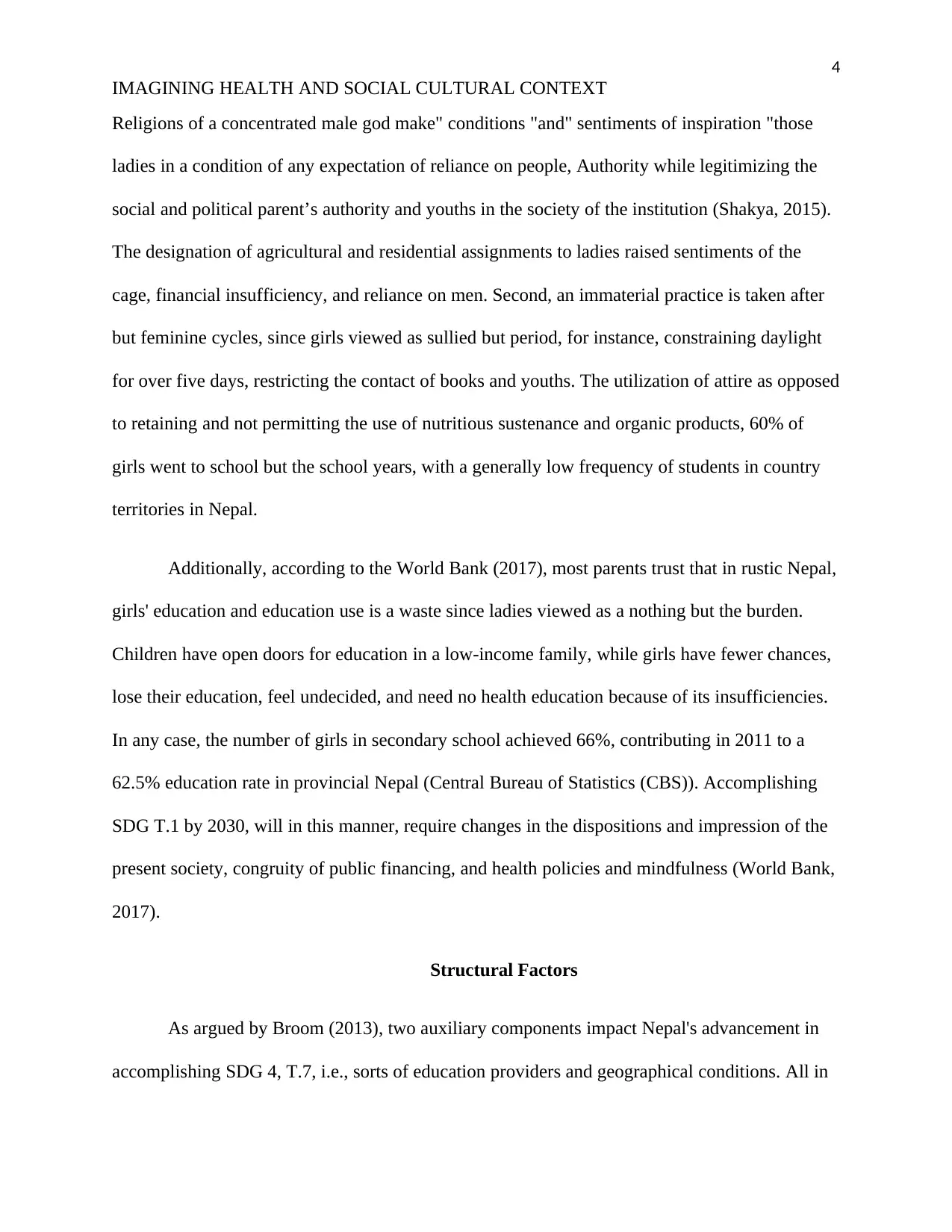
4
IMAGINING HEALTH AND SOCIAL CULTURAL CONTEXT
Religions of a concentrated male god make" conditions "and" sentiments of inspiration "those
ladies in a condition of any expectation of reliance on people, Authority while legitimizing the
social and political parent’s authority and youths in the society of the institution (Shakya, 2015).
The designation of agricultural and residential assignments to ladies raised sentiments of the
cage, financial insufficiency, and reliance on men. Second, an immaterial practice is taken after
but feminine cycles, since girls viewed as sullied but period, for instance, constraining daylight
for over five days, restricting the contact of books and youths. The utilization of attire as opposed
to retaining and not permitting the use of nutritious sustenance and organic products, 60% of
girls went to school but the school years, with a generally low frequency of students in country
territories in Nepal.
Additionally, according to the World Bank (2017), most parents trust that in rustic Nepal,
girls' education and education use is a waste since ladies viewed as a nothing but the burden.
Children have open doors for education in a low-income family, while girls have fewer chances,
lose their education, feel undecided, and need no health education because of its insufficiencies.
In any case, the number of girls in secondary school achieved 66%, contributing in 2011 to a
62.5% education rate in provincial Nepal (Central Bureau of Statistics (CBS)). Accomplishing
SDG T.1 by 2030, will in this manner, require changes in the dispositions and impression of the
present society, congruity of public financing, and health policies and mindfulness (World Bank,
2017).
Structural Factors
As argued by Broom (2013), two auxiliary components impact Nepal's advancement in
accomplishing SDG 4, T.7, i.e., sorts of education providers and geographical conditions. All in
IMAGINING HEALTH AND SOCIAL CULTURAL CONTEXT
Religions of a concentrated male god make" conditions "and" sentiments of inspiration "those
ladies in a condition of any expectation of reliance on people, Authority while legitimizing the
social and political parent’s authority and youths in the society of the institution (Shakya, 2015).
The designation of agricultural and residential assignments to ladies raised sentiments of the
cage, financial insufficiency, and reliance on men. Second, an immaterial practice is taken after
but feminine cycles, since girls viewed as sullied but period, for instance, constraining daylight
for over five days, restricting the contact of books and youths. The utilization of attire as opposed
to retaining and not permitting the use of nutritious sustenance and organic products, 60% of
girls went to school but the school years, with a generally low frequency of students in country
territories in Nepal.
Additionally, according to the World Bank (2017), most parents trust that in rustic Nepal,
girls' education and education use is a waste since ladies viewed as a nothing but the burden.
Children have open doors for education in a low-income family, while girls have fewer chances,
lose their education, feel undecided, and need no health education because of its insufficiencies.
In any case, the number of girls in secondary school achieved 66%, contributing in 2011 to a
62.5% education rate in provincial Nepal (Central Bureau of Statistics (CBS)). Accomplishing
SDG T.1 by 2030, will in this manner, require changes in the dispositions and impression of the
present society, congruity of public financing, and health policies and mindfulness (World Bank,
2017).
Structural Factors
As argued by Broom (2013), two auxiliary components impact Nepal's advancement in
accomplishing SDG 4, T.7, i.e., sorts of education providers and geographical conditions. All in
Paraphrase This Document
Need a fresh take? Get an instant paraphrase of this document with our AI Paraphraser
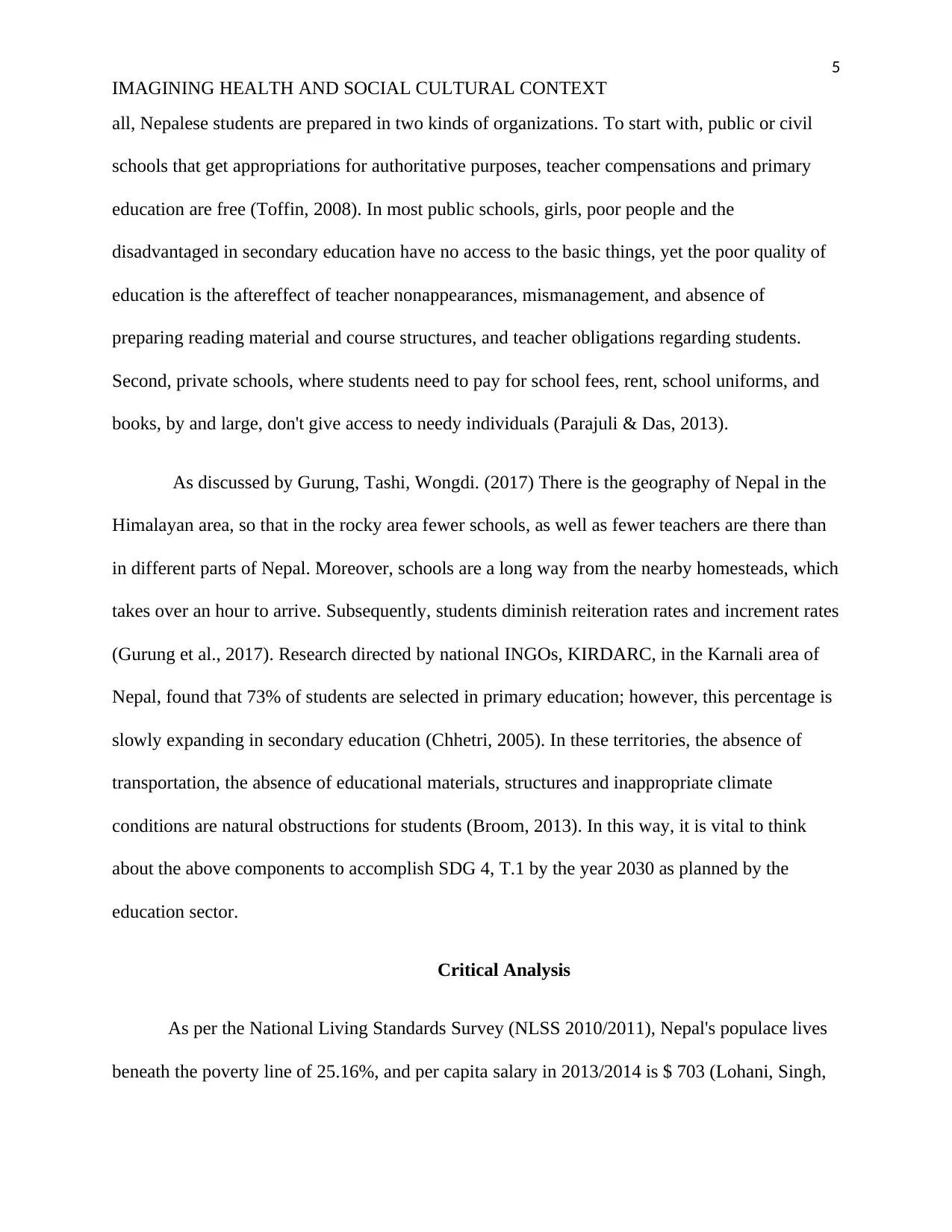
5
IMAGINING HEALTH AND SOCIAL CULTURAL CONTEXT
all, Nepalese students are prepared in two kinds of organizations. To start with, public or civil
schools that get appropriations for authoritative purposes, teacher compensations and primary
education are free (Toffin, 2008). In most public schools, girls, poor people and the
disadvantaged in secondary education have no access to the basic things, yet the poor quality of
education is the aftereffect of teacher nonappearances, mismanagement, and absence of
preparing reading material and course structures, and teacher obligations regarding students.
Second, private schools, where students need to pay for school fees, rent, school uniforms, and
books, by and large, don't give access to needy individuals (Parajuli & Das, 2013).
As discussed by Gurung, Tashi, Wongdi. (2017) There is the geography of Nepal in the
Himalayan area, so that in the rocky area fewer schools, as well as fewer teachers are there than
in different parts of Nepal. Moreover, schools are a long way from the nearby homesteads, which
takes over an hour to arrive. Subsequently, students diminish reiteration rates and increment rates
(Gurung et al., 2017). Research directed by national INGOs, KIRDARC, in the Karnali area of
Nepal, found that 73% of students are selected in primary education; however, this percentage is
slowly expanding in secondary education (Chhetri, 2005). In these territories, the absence of
transportation, the absence of educational materials, structures and inappropriate climate
conditions are natural obstructions for students (Broom, 2013). In this way, it is vital to think
about the above components to accomplish SDG 4, T.1 by the year 2030 as planned by the
education sector.
Critical Analysis
As per the National Living Standards Survey (NLSS 2010/2011), Nepal's populace lives
beneath the poverty line of 25.16%, and per capita salary in 2013/2014 is $ 703 (Lohani, Singh,
IMAGINING HEALTH AND SOCIAL CULTURAL CONTEXT
all, Nepalese students are prepared in two kinds of organizations. To start with, public or civil
schools that get appropriations for authoritative purposes, teacher compensations and primary
education are free (Toffin, 2008). In most public schools, girls, poor people and the
disadvantaged in secondary education have no access to the basic things, yet the poor quality of
education is the aftereffect of teacher nonappearances, mismanagement, and absence of
preparing reading material and course structures, and teacher obligations regarding students.
Second, private schools, where students need to pay for school fees, rent, school uniforms, and
books, by and large, don't give access to needy individuals (Parajuli & Das, 2013).
As discussed by Gurung, Tashi, Wongdi. (2017) There is the geography of Nepal in the
Himalayan area, so that in the rocky area fewer schools, as well as fewer teachers are there than
in different parts of Nepal. Moreover, schools are a long way from the nearby homesteads, which
takes over an hour to arrive. Subsequently, students diminish reiteration rates and increment rates
(Gurung et al., 2017). Research directed by national INGOs, KIRDARC, in the Karnali area of
Nepal, found that 73% of students are selected in primary education; however, this percentage is
slowly expanding in secondary education (Chhetri, 2005). In these territories, the absence of
transportation, the absence of educational materials, structures and inappropriate climate
conditions are natural obstructions for students (Broom, 2013). In this way, it is vital to think
about the above components to accomplish SDG 4, T.1 by the year 2030 as planned by the
education sector.
Critical Analysis
As per the National Living Standards Survey (NLSS 2010/2011), Nepal's populace lives
beneath the poverty line of 25.16%, and per capita salary in 2013/2014 is $ 703 (Lohani, Singh,
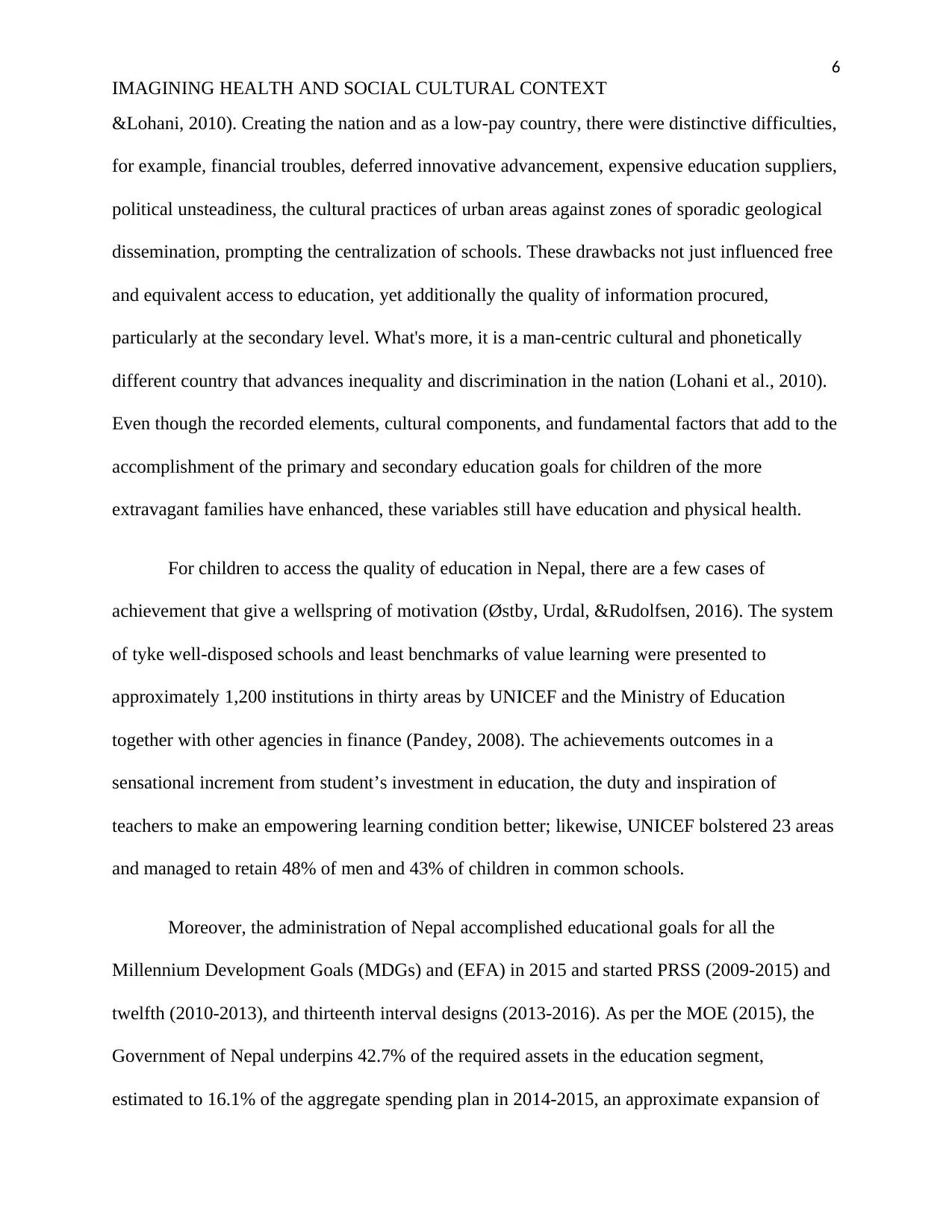
6
IMAGINING HEALTH AND SOCIAL CULTURAL CONTEXT
&Lohani, 2010). Creating the nation and as a low-pay country, there were distinctive difficulties,
for example, financial troubles, deferred innovative advancement, expensive education suppliers,
political unsteadiness, the cultural practices of urban areas against zones of sporadic geological
dissemination, prompting the centralization of schools. These drawbacks not just influenced free
and equivalent access to education, yet additionally the quality of information procured,
particularly at the secondary level. What's more, it is a man-centric cultural and phonetically
different country that advances inequality and discrimination in the nation (Lohani et al., 2010).
Even though the recorded elements, cultural components, and fundamental factors that add to the
accomplishment of the primary and secondary education goals for children of the more
extravagant families have enhanced, these variables still have education and physical health.
For children to access the quality of education in Nepal, there are a few cases of
achievement that give a wellspring of motivation (Østby, Urdal, &Rudolfsen, 2016). The system
of tyke well-disposed schools and least benchmarks of value learning were presented to
approximately 1,200 institutions in thirty areas by UNICEF and the Ministry of Education
together with other agencies in finance (Pandey, 2008). The achievements outcomes in a
sensational increment from student’s investment in education, the duty and inspiration of
teachers to make an empowering learning condition better; likewise, UNICEF bolstered 23 areas
and managed to retain 48% of men and 43% of children in common schools.
Moreover, the administration of Nepal accomplished educational goals for all the
Millennium Development Goals (MDGs) and (EFA) in 2015 and started PRSS (2009-2015) and
twelfth (2010-2013), and thirteenth interval designs (2013-2016). As per the MOE (2015), the
Government of Nepal underpins 42.7% of the required assets in the education segment,
estimated to 16.1% of the aggregate spending plan in 2014-2015, an approximate expansion of
IMAGINING HEALTH AND SOCIAL CULTURAL CONTEXT
&Lohani, 2010). Creating the nation and as a low-pay country, there were distinctive difficulties,
for example, financial troubles, deferred innovative advancement, expensive education suppliers,
political unsteadiness, the cultural practices of urban areas against zones of sporadic geological
dissemination, prompting the centralization of schools. These drawbacks not just influenced free
and equivalent access to education, yet additionally the quality of information procured,
particularly at the secondary level. What's more, it is a man-centric cultural and phonetically
different country that advances inequality and discrimination in the nation (Lohani et al., 2010).
Even though the recorded elements, cultural components, and fundamental factors that add to the
accomplishment of the primary and secondary education goals for children of the more
extravagant families have enhanced, these variables still have education and physical health.
For children to access the quality of education in Nepal, there are a few cases of
achievement that give a wellspring of motivation (Østby, Urdal, &Rudolfsen, 2016). The system
of tyke well-disposed schools and least benchmarks of value learning were presented to
approximately 1,200 institutions in thirty areas by UNICEF and the Ministry of Education
together with other agencies in finance (Pandey, 2008). The achievements outcomes in a
sensational increment from student’s investment in education, the duty and inspiration of
teachers to make an empowering learning condition better; likewise, UNICEF bolstered 23 areas
and managed to retain 48% of men and 43% of children in common schools.
Moreover, the administration of Nepal accomplished educational goals for all the
Millennium Development Goals (MDGs) and (EFA) in 2015 and started PRSS (2009-2015) and
twelfth (2010-2013), and thirteenth interval designs (2013-2016). As per the MOE (2015), the
Government of Nepal underpins 42.7% of the required assets in the education segment,
estimated to 16.1% of the aggregate spending plan in 2014-2015, an approximate expansion of
⊘ This is a preview!⊘
Do you want full access?
Subscribe today to unlock all pages.

Trusted by 1+ million students worldwide
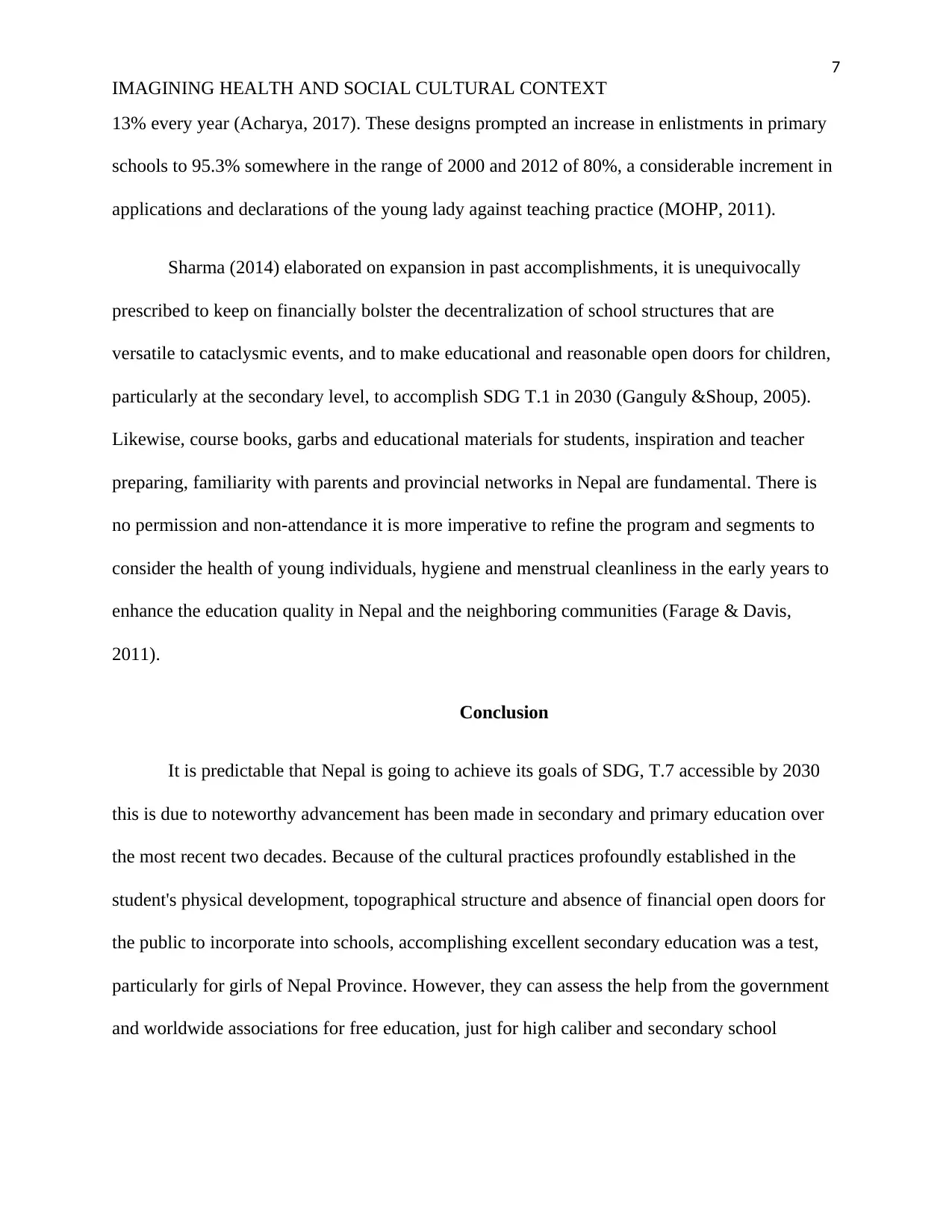
7
IMAGINING HEALTH AND SOCIAL CULTURAL CONTEXT
13% every year (Acharya, 2017). These designs prompted an increase in enlistments in primary
schools to 95.3% somewhere in the range of 2000 and 2012 of 80%, a considerable increment in
applications and declarations of the young lady against teaching practice (MOHP, 2011).
Sharma (2014) elaborated on expansion in past accomplishments, it is unequivocally
prescribed to keep on financially bolster the decentralization of school structures that are
versatile to cataclysmic events, and to make educational and reasonable open doors for children,
particularly at the secondary level, to accomplish SDG T.1 in 2030 (Ganguly &Shoup, 2005).
Likewise, course books, garbs and educational materials for students, inspiration and teacher
preparing, familiarity with parents and provincial networks in Nepal are fundamental. There is
no permission and non-attendance it is more imperative to refine the program and segments to
consider the health of young individuals, hygiene and menstrual cleanliness in the early years to
enhance the education quality in Nepal and the neighboring communities (Farage & Davis,
2011).
Conclusion
It is predictable that Nepal is going to achieve its goals of SDG, T.7 accessible by 2030
this is due to noteworthy advancement has been made in secondary and primary education over
the most recent two decades. Because of the cultural practices profoundly established in the
student's physical development, topographical structure and absence of financial open doors for
the public to incorporate into schools, accomplishing excellent secondary education was a test,
particularly for girls of Nepal Province. However, they can assess the help from the government
and worldwide associations for free education, just for high caliber and secondary school
IMAGINING HEALTH AND SOCIAL CULTURAL CONTEXT
13% every year (Acharya, 2017). These designs prompted an increase in enlistments in primary
schools to 95.3% somewhere in the range of 2000 and 2012 of 80%, a considerable increment in
applications and declarations of the young lady against teaching practice (MOHP, 2011).
Sharma (2014) elaborated on expansion in past accomplishments, it is unequivocally
prescribed to keep on financially bolster the decentralization of school structures that are
versatile to cataclysmic events, and to make educational and reasonable open doors for children,
particularly at the secondary level, to accomplish SDG T.1 in 2030 (Ganguly &Shoup, 2005).
Likewise, course books, garbs and educational materials for students, inspiration and teacher
preparing, familiarity with parents and provincial networks in Nepal are fundamental. There is
no permission and non-attendance it is more imperative to refine the program and segments to
consider the health of young individuals, hygiene and menstrual cleanliness in the early years to
enhance the education quality in Nepal and the neighboring communities (Farage & Davis,
2011).
Conclusion
It is predictable that Nepal is going to achieve its goals of SDG, T.7 accessible by 2030
this is due to noteworthy advancement has been made in secondary and primary education over
the most recent two decades. Because of the cultural practices profoundly established in the
student's physical development, topographical structure and absence of financial open doors for
the public to incorporate into schools, accomplishing excellent secondary education was a test,
particularly for girls of Nepal Province. However, they can assess the help from the government
and worldwide associations for free education, just for high caliber and secondary school
Paraphrase This Document
Need a fresh take? Get an instant paraphrase of this document with our AI Paraphraser
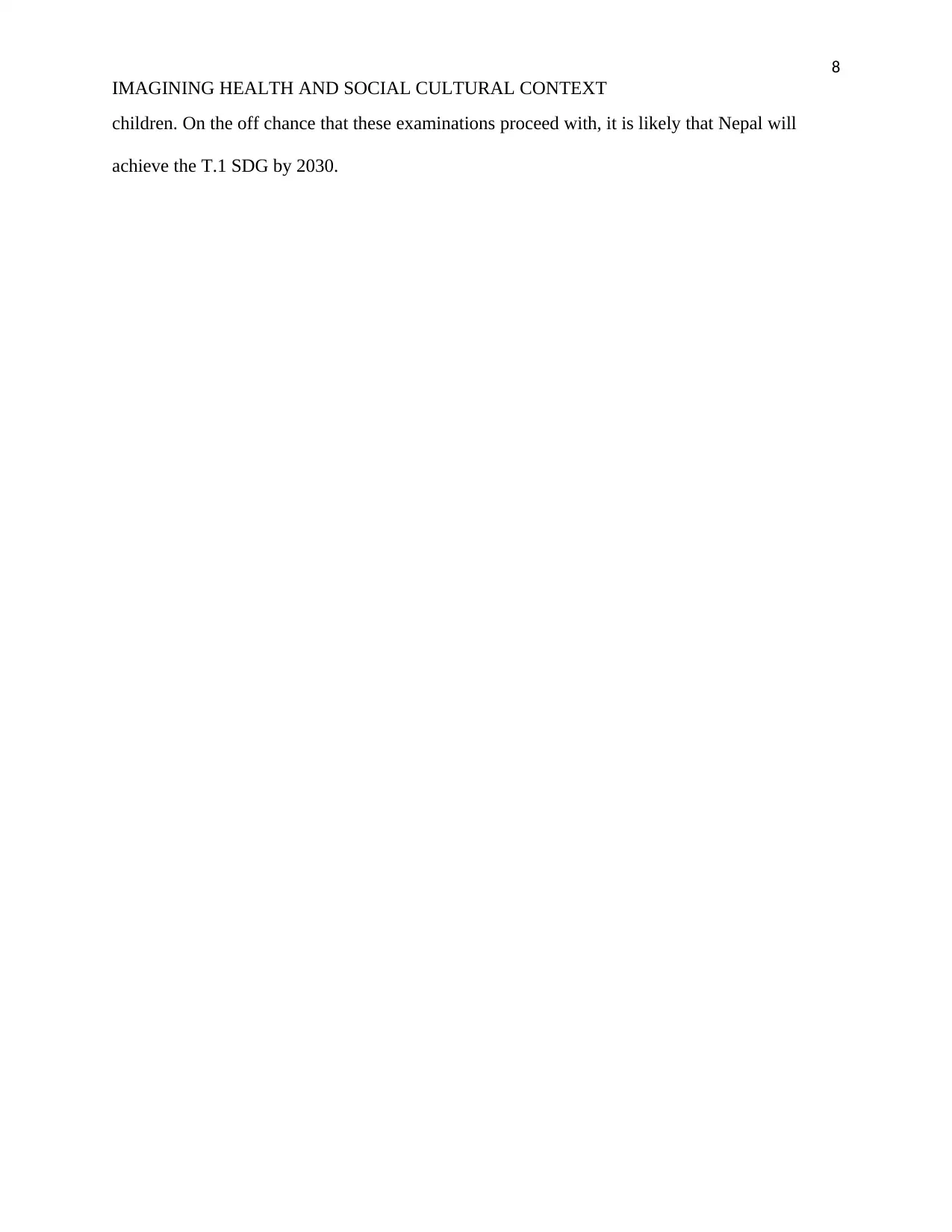
8
IMAGINING HEALTH AND SOCIAL CULTURAL CONTEXT
children. On the off chance that these examinations proceed with, it is likely that Nepal will
achieve the T.1 SDG by 2030.
IMAGINING HEALTH AND SOCIAL CULTURAL CONTEXT
children. On the off chance that these examinations proceed with, it is likely that Nepal will
achieve the T.1 SDG by 2030.
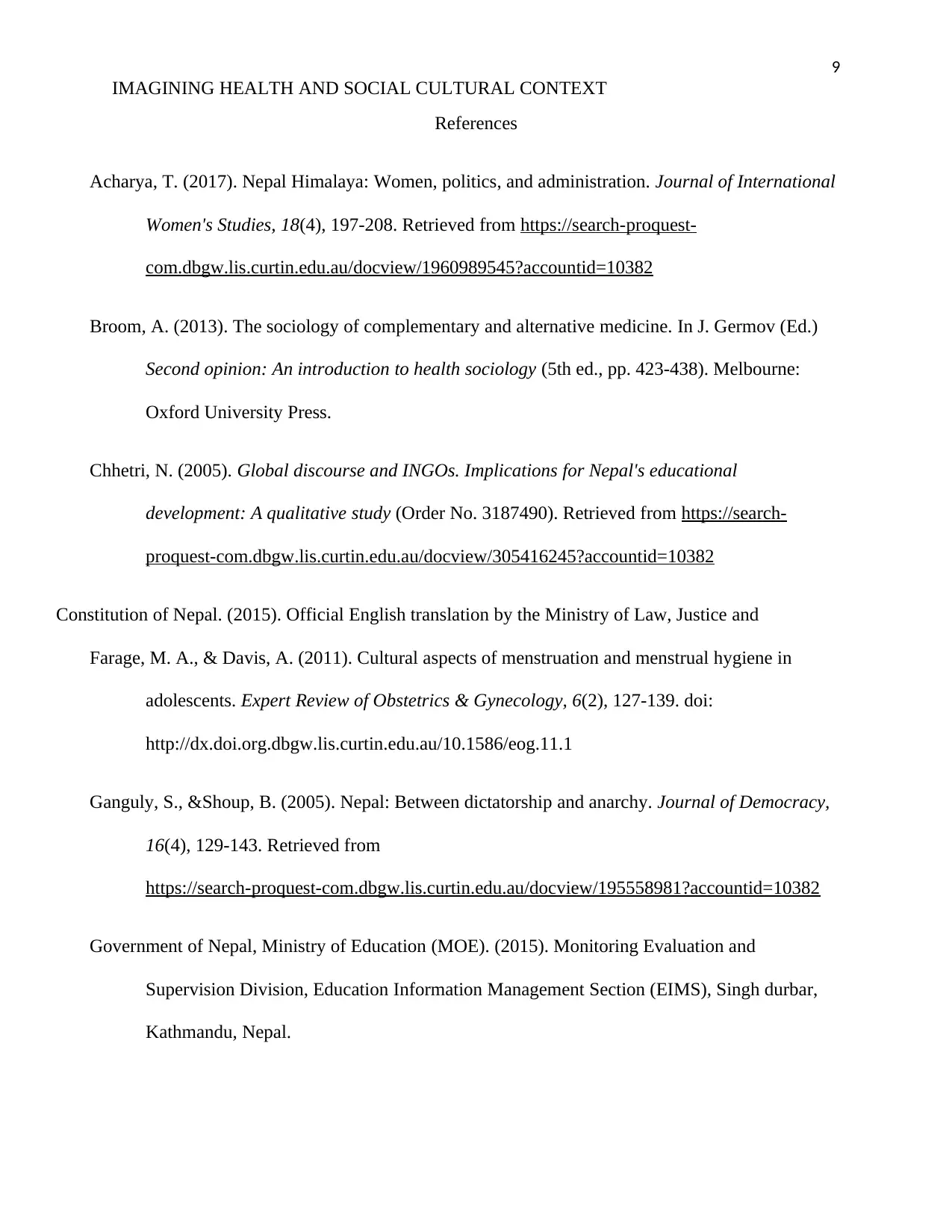
9
IMAGINING HEALTH AND SOCIAL CULTURAL CONTEXT
References
Acharya, T. (2017). Nepal Himalaya: Women, politics, and administration. Journal of International
Women's Studies, 18(4), 197-208. Retrieved from https://search-proquest-
com.dbgw.lis.curtin.edu.au/docview/1960989545?accountid=10382
Broom, A. (2013). The sociology of complementary and alternative medicine. In J. Germov (Ed.)
Second opinion: An introduction to health sociology (5th ed., pp. 423-438). Melbourne:
Oxford University Press.
Chhetri, N. (2005). Global discourse and INGOs. Implications for Nepal's educational
development: A qualitative study (Order No. 3187490). Retrieved from https://search-
proquest-com.dbgw.lis.curtin.edu.au/docview/305416245?accountid=10382
Constitution of Nepal. (2015). Official English translation by the Ministry of Law, Justice and
Farage, M. A., & Davis, A. (2011). Cultural aspects of menstruation and menstrual hygiene in
adolescents. Expert Review of Obstetrics & Gynecology, 6(2), 127-139. doi:
http://dx.doi.org.dbgw.lis.curtin.edu.au/10.1586/eog.11.1
Ganguly, S., &Shoup, B. (2005). Nepal: Between dictatorship and anarchy. Journal of Democracy,
16(4), 129-143. Retrieved from
https://search-proquest-com.dbgw.lis.curtin.edu.au/docview/195558981?accountid=10382
Government of Nepal, Ministry of Education (MOE). (2015). Monitoring Evaluation and
Supervision Division, Education Information Management Section (EIMS), Singh durbar,
Kathmandu, Nepal.
IMAGINING HEALTH AND SOCIAL CULTURAL CONTEXT
References
Acharya, T. (2017). Nepal Himalaya: Women, politics, and administration. Journal of International
Women's Studies, 18(4), 197-208. Retrieved from https://search-proquest-
com.dbgw.lis.curtin.edu.au/docview/1960989545?accountid=10382
Broom, A. (2013). The sociology of complementary and alternative medicine. In J. Germov (Ed.)
Second opinion: An introduction to health sociology (5th ed., pp. 423-438). Melbourne:
Oxford University Press.
Chhetri, N. (2005). Global discourse and INGOs. Implications for Nepal's educational
development: A qualitative study (Order No. 3187490). Retrieved from https://search-
proquest-com.dbgw.lis.curtin.edu.au/docview/305416245?accountid=10382
Constitution of Nepal. (2015). Official English translation by the Ministry of Law, Justice and
Farage, M. A., & Davis, A. (2011). Cultural aspects of menstruation and menstrual hygiene in
adolescents. Expert Review of Obstetrics & Gynecology, 6(2), 127-139. doi:
http://dx.doi.org.dbgw.lis.curtin.edu.au/10.1586/eog.11.1
Ganguly, S., &Shoup, B. (2005). Nepal: Between dictatorship and anarchy. Journal of Democracy,
16(4), 129-143. Retrieved from
https://search-proquest-com.dbgw.lis.curtin.edu.au/docview/195558981?accountid=10382
Government of Nepal, Ministry of Education (MOE). (2015). Monitoring Evaluation and
Supervision Division, Education Information Management Section (EIMS), Singh durbar,
Kathmandu, Nepal.
⊘ This is a preview!⊘
Do you want full access?
Subscribe today to unlock all pages.

Trusted by 1+ million students worldwide
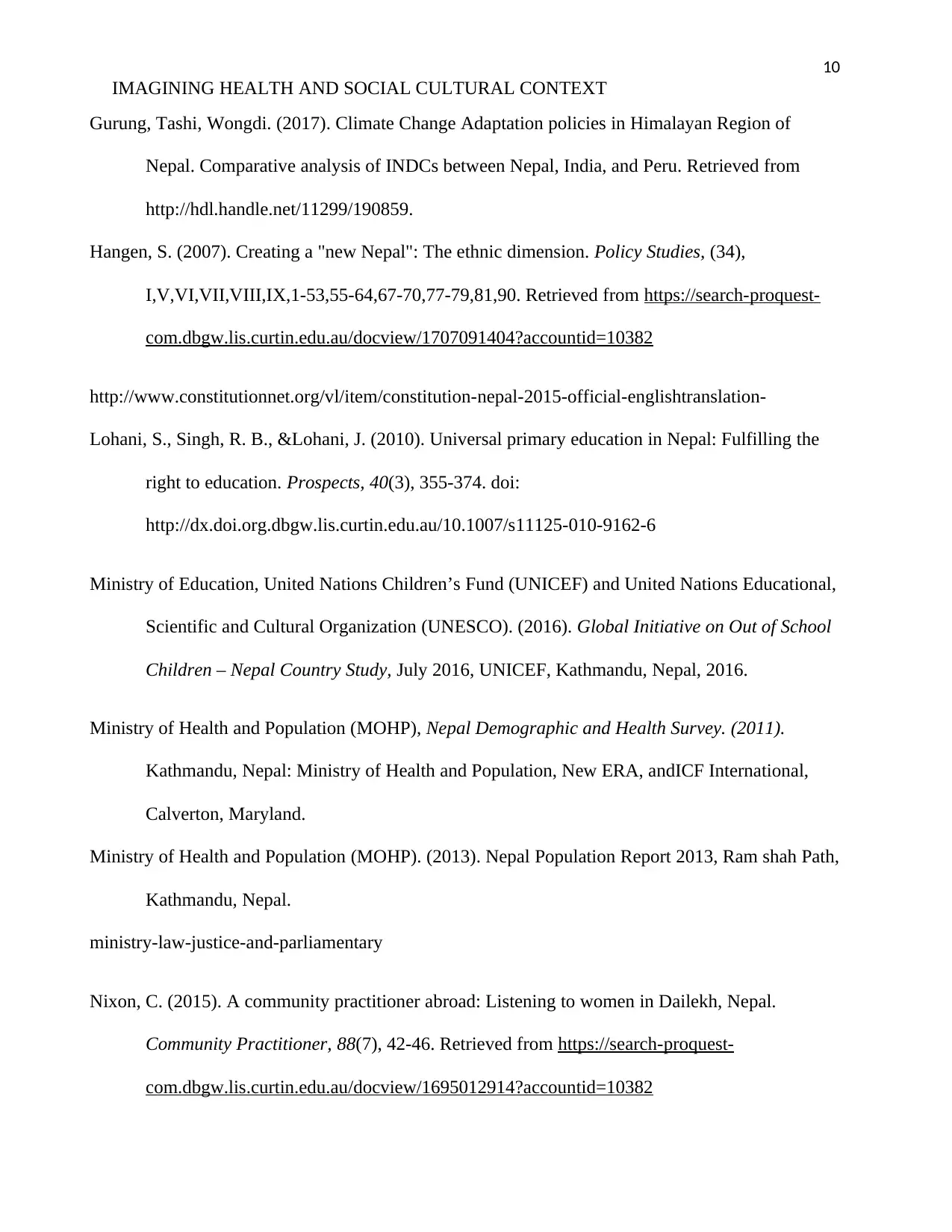
10
IMAGINING HEALTH AND SOCIAL CULTURAL CONTEXT
Gurung, Tashi, Wongdi. (2017). Climate Change Adaptation policies in Himalayan Region of
Nepal. Comparative analysis of INDCs between Nepal, India, and Peru. Retrieved from
http://hdl.handle.net/11299/190859.
Hangen, S. (2007). Creating a "new Nepal": The ethnic dimension. Policy Studies, (34),
I,V,VI,VII,VIII,IX,1-53,55-64,67-70,77-79,81,90. Retrieved from https://search-proquest-
com.dbgw.lis.curtin.edu.au/docview/1707091404?accountid=10382
http://www.constitutionnet.org/vl/item/constitution-nepal-2015-official-englishtranslation-
Lohani, S., Singh, R. B., &Lohani, J. (2010). Universal primary education in Nepal: Fulfilling the
right to education. Prospects, 40(3), 355-374. doi:
http://dx.doi.org.dbgw.lis.curtin.edu.au/10.1007/s11125-010-9162-6
Ministry of Education, United Nations Children’s Fund (UNICEF) and United Nations Educational,
Scientific and Cultural Organization (UNESCO). (2016). Global Initiative on Out of School
Children – Nepal Country Study, July 2016, UNICEF, Kathmandu, Nepal, 2016.
Ministry of Health and Population (MOHP), Nepal Demographic and Health Survey. (2011).
Kathmandu, Nepal: Ministry of Health and Population, New ERA, andICF International,
Calverton, Maryland.
Ministry of Health and Population (MOHP). (2013). Nepal Population Report 2013, Ram shah Path,
Kathmandu, Nepal.
ministry-law-justice-and-parliamentary
Nixon, C. (2015). A community practitioner abroad: Listening to women in Dailekh, Nepal.
Community Practitioner, 88(7), 42-46. Retrieved from https://search-proquest-
com.dbgw.lis.curtin.edu.au/docview/1695012914?accountid=10382
IMAGINING HEALTH AND SOCIAL CULTURAL CONTEXT
Gurung, Tashi, Wongdi. (2017). Climate Change Adaptation policies in Himalayan Region of
Nepal. Comparative analysis of INDCs between Nepal, India, and Peru. Retrieved from
http://hdl.handle.net/11299/190859.
Hangen, S. (2007). Creating a "new Nepal": The ethnic dimension. Policy Studies, (34),
I,V,VI,VII,VIII,IX,1-53,55-64,67-70,77-79,81,90. Retrieved from https://search-proquest-
com.dbgw.lis.curtin.edu.au/docview/1707091404?accountid=10382
http://www.constitutionnet.org/vl/item/constitution-nepal-2015-official-englishtranslation-
Lohani, S., Singh, R. B., &Lohani, J. (2010). Universal primary education in Nepal: Fulfilling the
right to education. Prospects, 40(3), 355-374. doi:
http://dx.doi.org.dbgw.lis.curtin.edu.au/10.1007/s11125-010-9162-6
Ministry of Education, United Nations Children’s Fund (UNICEF) and United Nations Educational,
Scientific and Cultural Organization (UNESCO). (2016). Global Initiative on Out of School
Children – Nepal Country Study, July 2016, UNICEF, Kathmandu, Nepal, 2016.
Ministry of Health and Population (MOHP), Nepal Demographic and Health Survey. (2011).
Kathmandu, Nepal: Ministry of Health and Population, New ERA, andICF International,
Calverton, Maryland.
Ministry of Health and Population (MOHP). (2013). Nepal Population Report 2013, Ram shah Path,
Kathmandu, Nepal.
ministry-law-justice-and-parliamentary
Nixon, C. (2015). A community practitioner abroad: Listening to women in Dailekh, Nepal.
Community Practitioner, 88(7), 42-46. Retrieved from https://search-proquest-
com.dbgw.lis.curtin.edu.au/docview/1695012914?accountid=10382
Paraphrase This Document
Need a fresh take? Get an instant paraphrase of this document with our AI Paraphraser
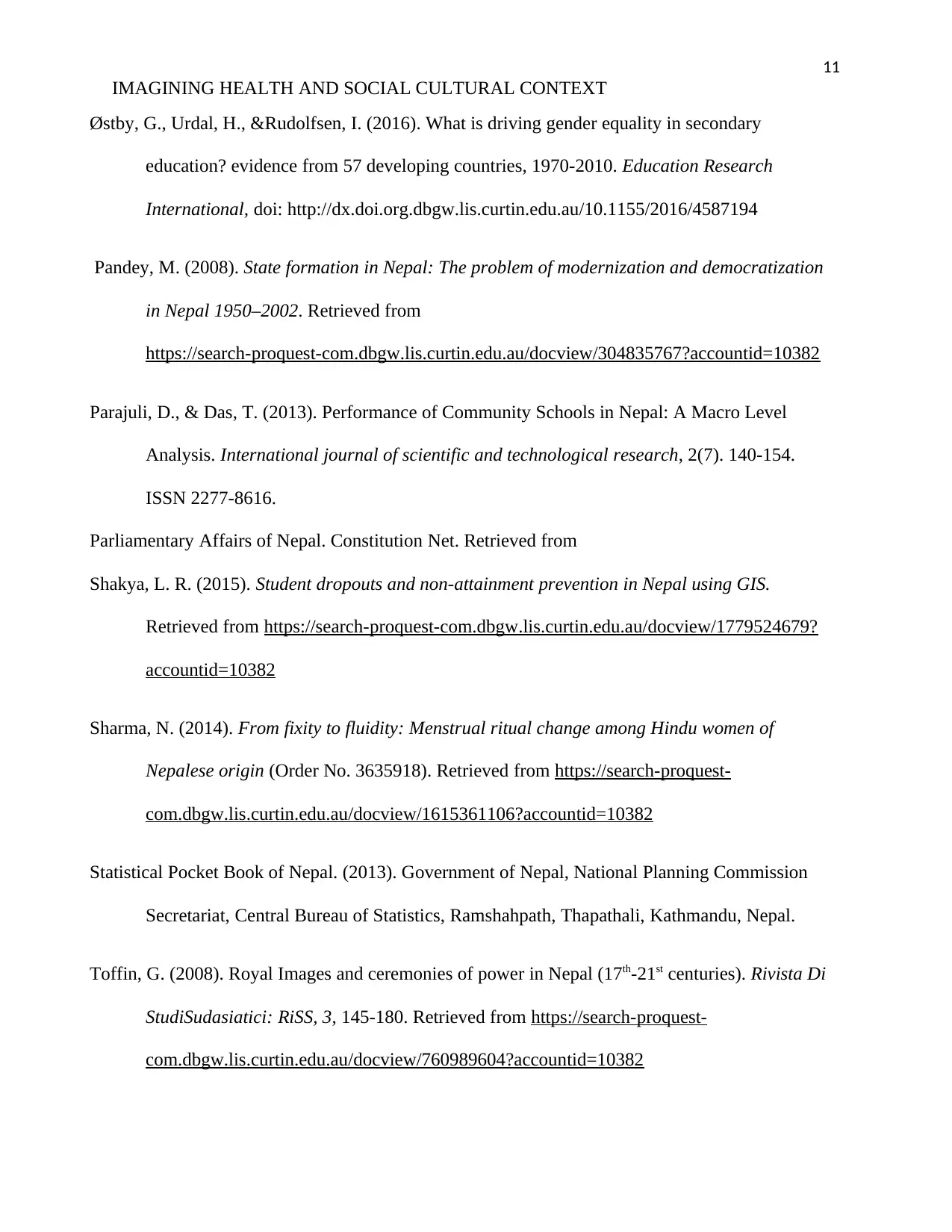
11
IMAGINING HEALTH AND SOCIAL CULTURAL CONTEXT
Østby, G., Urdal, H., &Rudolfsen, I. (2016). What is driving gender equality in secondary
education? evidence from 57 developing countries, 1970-2010. Education Research
International, doi: http://dx.doi.org.dbgw.lis.curtin.edu.au/10.1155/2016/4587194
Pandey, M. (2008). State formation in Nepal: The problem of modernization and democratization
in Nepal 1950–2002. Retrieved from
https://search-proquest-com.dbgw.lis.curtin.edu.au/docview/304835767?accountid=10382
Parajuli, D., & Das, T. (2013). Performance of Community Schools in Nepal: A Macro Level
Analysis. International journal of scientific and technological research, 2(7). 140-154.
ISSN 2277-8616.
Parliamentary Affairs of Nepal. Constitution Net. Retrieved from
Shakya, L. R. (2015). Student dropouts and non-attainment prevention in Nepal using GIS.
Retrieved from https://search-proquest-com.dbgw.lis.curtin.edu.au/docview/1779524679?
accountid=10382
Sharma, N. (2014). From fixity to fluidity: Menstrual ritual change among Hindu women of
Nepalese origin (Order No. 3635918). Retrieved from https://search-proquest-
com.dbgw.lis.curtin.edu.au/docview/1615361106?accountid=10382
Statistical Pocket Book of Nepal. (2013). Government of Nepal, National Planning Commission
Secretariat, Central Bureau of Statistics, Ramshahpath, Thapathali, Kathmandu, Nepal.
Toffin, G. (2008). Royal Images and ceremonies of power in Nepal (17th-21st centuries). Rivista Di
StudiSudasiatici: RiSS, 3, 145-180. Retrieved from https://search-proquest-
com.dbgw.lis.curtin.edu.au/docview/760989604?accountid=10382
IMAGINING HEALTH AND SOCIAL CULTURAL CONTEXT
Østby, G., Urdal, H., &Rudolfsen, I. (2016). What is driving gender equality in secondary
education? evidence from 57 developing countries, 1970-2010. Education Research
International, doi: http://dx.doi.org.dbgw.lis.curtin.edu.au/10.1155/2016/4587194
Pandey, M. (2008). State formation in Nepal: The problem of modernization and democratization
in Nepal 1950–2002. Retrieved from
https://search-proquest-com.dbgw.lis.curtin.edu.au/docview/304835767?accountid=10382
Parajuli, D., & Das, T. (2013). Performance of Community Schools in Nepal: A Macro Level
Analysis. International journal of scientific and technological research, 2(7). 140-154.
ISSN 2277-8616.
Parliamentary Affairs of Nepal. Constitution Net. Retrieved from
Shakya, L. R. (2015). Student dropouts and non-attainment prevention in Nepal using GIS.
Retrieved from https://search-proquest-com.dbgw.lis.curtin.edu.au/docview/1779524679?
accountid=10382
Sharma, N. (2014). From fixity to fluidity: Menstrual ritual change among Hindu women of
Nepalese origin (Order No. 3635918). Retrieved from https://search-proquest-
com.dbgw.lis.curtin.edu.au/docview/1615361106?accountid=10382
Statistical Pocket Book of Nepal. (2013). Government of Nepal, National Planning Commission
Secretariat, Central Bureau of Statistics, Ramshahpath, Thapathali, Kathmandu, Nepal.
Toffin, G. (2008). Royal Images and ceremonies of power in Nepal (17th-21st centuries). Rivista Di
StudiSudasiatici: RiSS, 3, 145-180. Retrieved from https://search-proquest-
com.dbgw.lis.curtin.edu.au/docview/760989604?accountid=10382
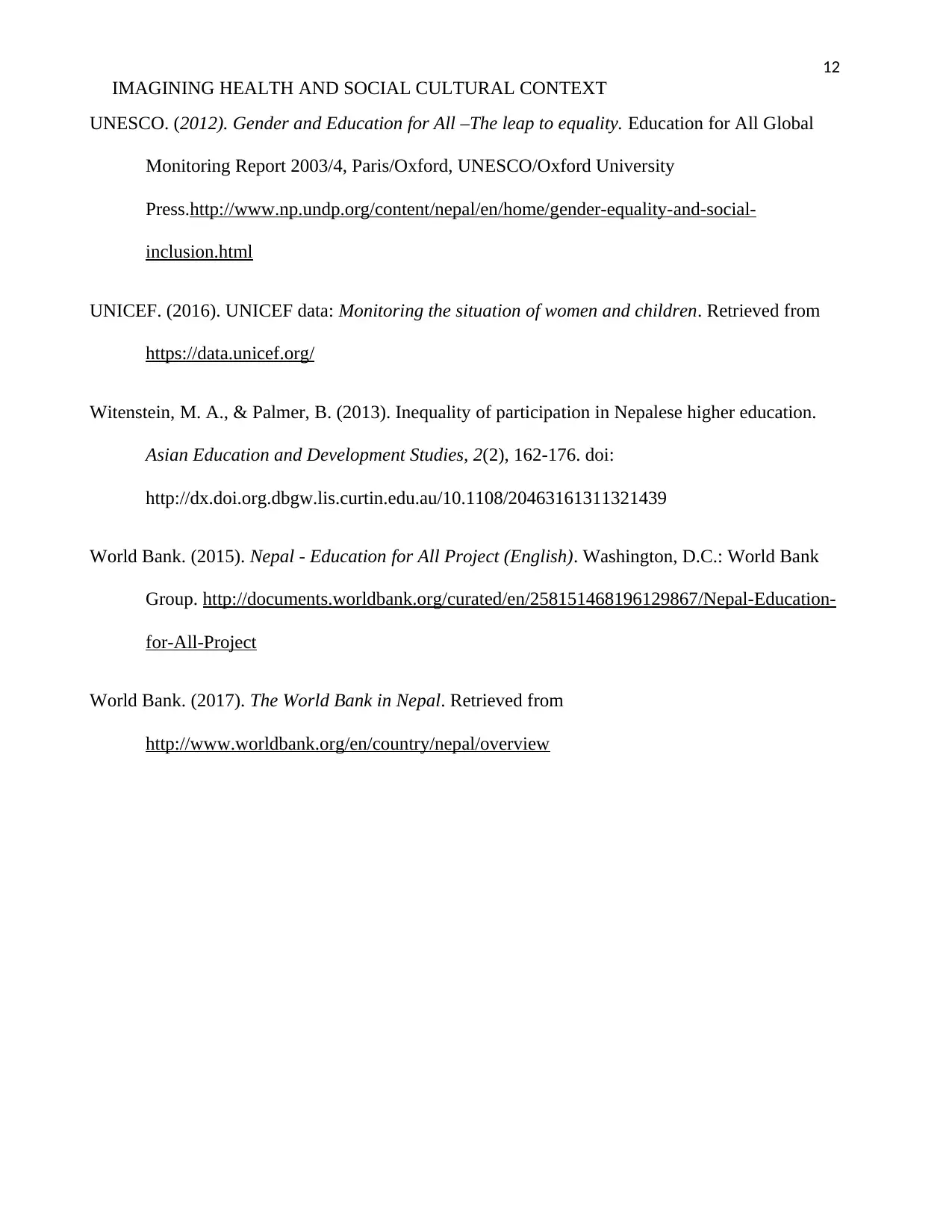
12
IMAGINING HEALTH AND SOCIAL CULTURAL CONTEXT
UNESCO. (2012). Gender and Education for All –The leap to equality. Education for All Global
Monitoring Report 2003/4, Paris/Oxford, UNESCO/Oxford University
Press.http://www.np.undp.org/content/nepal/en/home/gender-equality-and-social-
inclusion.html
UNICEF. (2016). UNICEF data: Monitoring the situation of women and children. Retrieved from
https://data.unicef.org/
Witenstein, M. A., & Palmer, B. (2013). Inequality of participation in Nepalese higher education.
Asian Education and Development Studies, 2(2), 162-176. doi:
http://dx.doi.org.dbgw.lis.curtin.edu.au/10.1108/20463161311321439
World Bank. (2015). Nepal - Education for All Project (English). Washington, D.C.: World Bank
Group. http://documents.worldbank.org/curated/en/258151468196129867/Nepal-Education-
for-All-Project
World Bank. (2017). The World Bank in Nepal. Retrieved from
http://www.worldbank.org/en/country/nepal/overview
IMAGINING HEALTH AND SOCIAL CULTURAL CONTEXT
UNESCO. (2012). Gender and Education for All –The leap to equality. Education for All Global
Monitoring Report 2003/4, Paris/Oxford, UNESCO/Oxford University
Press.http://www.np.undp.org/content/nepal/en/home/gender-equality-and-social-
inclusion.html
UNICEF. (2016). UNICEF data: Monitoring the situation of women and children. Retrieved from
https://data.unicef.org/
Witenstein, M. A., & Palmer, B. (2013). Inequality of participation in Nepalese higher education.
Asian Education and Development Studies, 2(2), 162-176. doi:
http://dx.doi.org.dbgw.lis.curtin.edu.au/10.1108/20463161311321439
World Bank. (2015). Nepal - Education for All Project (English). Washington, D.C.: World Bank
Group. http://documents.worldbank.org/curated/en/258151468196129867/Nepal-Education-
for-All-Project
World Bank. (2017). The World Bank in Nepal. Retrieved from
http://www.worldbank.org/en/country/nepal/overview
⊘ This is a preview!⊘
Do you want full access?
Subscribe today to unlock all pages.

Trusted by 1+ million students worldwide
1 out of 12
Your All-in-One AI-Powered Toolkit for Academic Success.
+13062052269
info@desklib.com
Available 24*7 on WhatsApp / Email
![[object Object]](/_next/static/media/star-bottom.7253800d.svg)
Unlock your academic potential
Copyright © 2020–2025 A2Z Services. All Rights Reserved. Developed and managed by ZUCOL.
